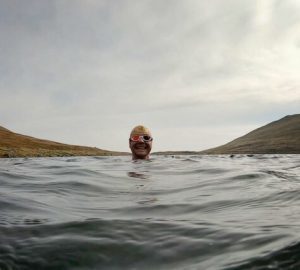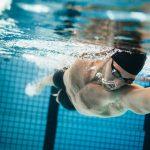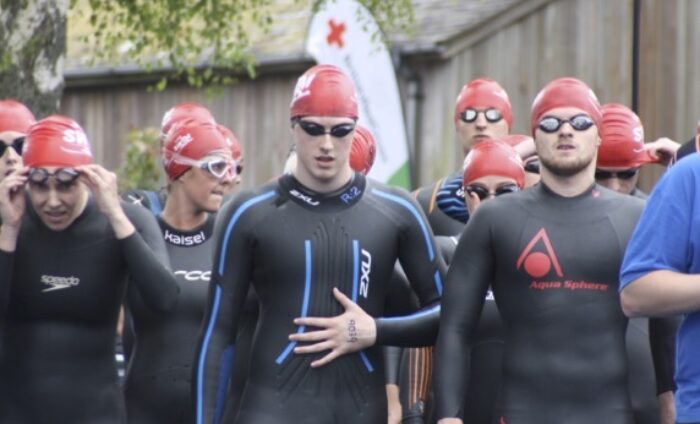
Your first swim
A swimmer’s first open water event is a magical milestone on their outdoor swimming journey but it can also be a bit daunting as you swim off into the unknown. Coach Jason Tait guides you through everything you need to know to have an enjoyable event
IT’S FINALLY HERE! Race day has arrived and you are
about to embark on your first open water swim event.
You’re feeling excited, nervous and maybe a little sick.
Don’t worry, the person next to you is probably feeling
exactly the same. Whether you signed up to your event
as a personal challenge, a charity swim or a drunken bet,
it’s time to start swimming!
You have spent the winter and spring training in the
pool. Before race day you have tested your wetsuit in the
open water and practised some open water skills, such as
sighting and drafting. So what else can you do to make
sure you’re ready for your big day?
The days before your event
Food prep
A few days before the event start to
eat a little more and increase your
carbohydrate intake as part of a
balanced diet. Get your body ready for
race day by fueling it properly, making
sure you are hydrated and the tank is
full. If you are doing a longer swim (yes,
many new open water swimmers jump
straight in at 10k) and plan on taking
gels or supplements, make sure these
agree with your body beforehand. Don’t
try a new brand of gel or energy drink
on race day. You should experiment
with these in training to find a
combination that works for you.
Sleep
Get an early night. Don’t stay up on a
device or drinking the night away with
friends. Most swimming events start
early, and registration is even earlier,
so you want to be nice and fresh and
prepared to wake up in good time.
Checklist
Make a checklist of what you need to
take. Read your event information to
make sure you have everything they
require, such as ID. An example list
would be:
- Registration and event information
- ID (passport/driver’s licence or
other picture ID if needed)
- Supplements and food
- Drinks
- Swim costume
- Wetsuit
- Goggles
- Spare goggles
- Swim hat
- Changing robe (if you have one)
- Flip flops (ones that you don’t mind losing)
A checklist makes sure you don’t have
the worry of forgetting things in your
excitement or panic on race day itself.
Pack the day before.
The big day
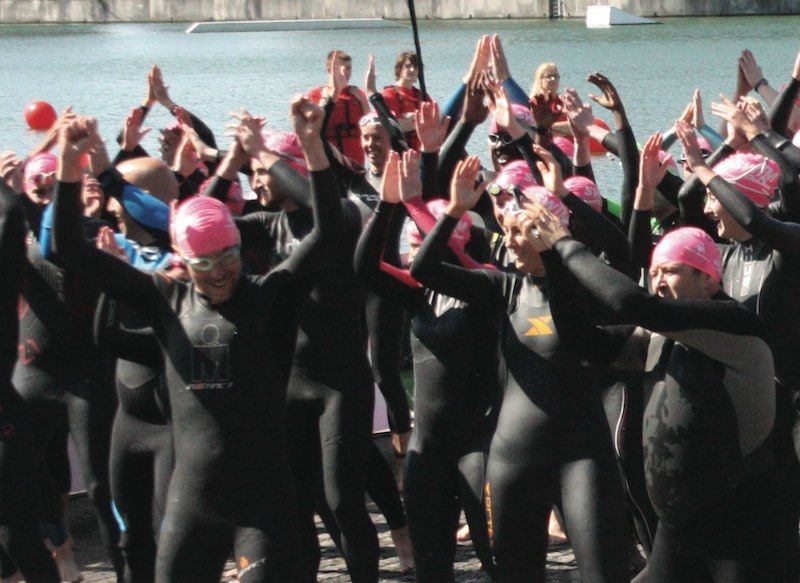
Food
Have something light to eat on the morning of your swim,
eg wholemeal toast or porridge. Eat at least a few hours
before you are due to swim and keep sipping water or
juice in the run-up to the start.
Travel
Allow plenty of time to get to the event, but don’t leave
too early (easy to say with your excitement). You don’t
want to be waiting around at the event venue too long,
especially if you are a nervous swimmer.
Expect queues for registration, toilets and food like at
any big event, but don’t let this frustrate you. Organisers
build in a good deal of time to get everybody sorted and
registered. Help them out by having everything you need
(such as ID) ready.
Follow the rules
Pay attention to the safety
briefing, race rules and registration
times. You have made it this far,
you don’t want to be late – or
worse, miss your race start
altogether. At many events if you
miss your start time you won’t be
allowed to join another wave.
Check the course
Do you know where you are going
once you get in the water? At
registration you will probably see
large boards with the course drawn
out so you can familiarise yourself
with the swim route. Once you are
happy with the course layout try
and take a walk next to it and look
for lines of sight and landmarks to
use while swimming.
Warm up
Do some light dynamic warm-
ups as your swim approaches
(arm swings, leg swings, light
stretches, jogging, etc). This will
get your heart rate up and muscles
prepped for the swim ahead. Do
some breathing exercises to help
stay calm and encourage a nice
breathing pattern.
Race time!
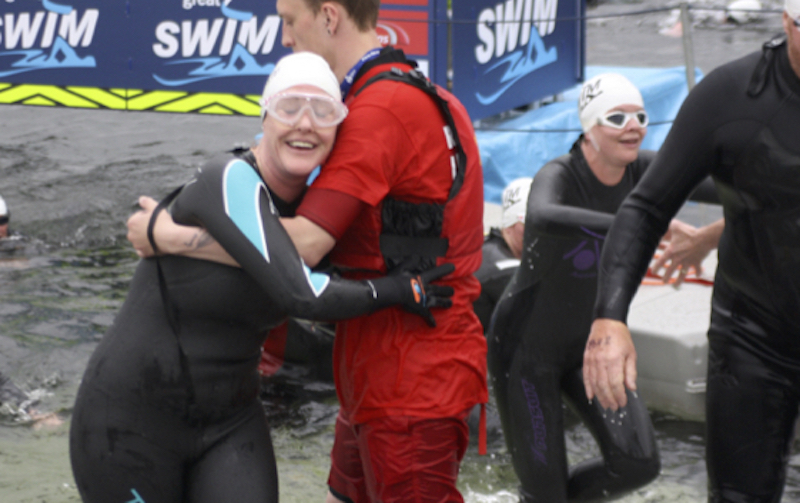
You’re in the water now, time to get
going and do this!
Just before
Most events will allow you a short time
to acclimatise in the water and do a
short warm-up swim. This is usually
no longer than 5-10 minutes and it will
be busy, but it is very important to get
into the water. Don’t worry if you only
get a chance to do a few strokes as you
have already warmed up your muscles
on land. Acclimatise yourself to the
water temperature and ensure you are
nice and relaxed in your breathing.
Perform some breathing exercises and
exhale a few nice deep breaths in the
water. The more relaxed you are the
better your swim will be.
The start
A group start is usually the busiest part
of the race and you may get knocked
around a little, but don’t let this
unnerve you.
Get into a position in the starting
pack where you are comfortable and
have your own space. If you know you
are a slower swimmer do not start near
the front, it is likely you will get swum
over, knocked and not have a happy
swim.
Once you have selected your start
position stick with it. To stay out
of trouble start at the back and to
the right if your first turn buoy is
on the left, and vice versa. This will
ensure you are on the outside of any
funnelling into the first turn buoy.
Be selfish
Become a selfish swimmer. Only
worry about your swim, nobody else’s.
Move around swimmers to stay out of
trouble and make your swim is as easy
as possible. Try and relax, and don’t
worry about what others are doing.
This is your swim and you are going to
smash it!
Look where you are going
Remember to sight! With everything
that’s going on around you it’s common
to forget this and end up off course.
Never just follow somebody’s feet
aimlessly. They could be the best and
straightest swimmer in the world or
the worst. If they go off course, so will
you.
Drafting
You may find yourself swimming on
somebody’s toes or by somebody’s side.
This actually makes your swim a little
easier and is known as drafting. The
only unwritten rule is not to constantly
touch somebody’s toes as it can be
annoying.
You are nearly there!
As you approach the finish, start to
sight a little more often. If you have
some energy left, sprint towards that
finish line. As you approach the line,
kick your legs a little more, being very
careful not to go so hard you cramp up.
This action will get the blood flowing
into your legs so when you stand to get
out the water you won’t be as dizzy.
Finish lines can also vary in open
water events. Some have a board that
you touch or swim under, and your
timing chip will stop at that point.
Others finish out of the water on the
bank; if this is the case make sure you
run to the finish line – there nothing
worse than putting in a big swim
effort to overtake somebody only to
have them run past you before the
finish line!
Afterwards
If it’s a cold day, don’t hang around. Get
changed into warm clothes as soon as
possible. Collect your medal, race souvenir,
timing slip and don’t forget to smile.
Post on social media how awesome you
are and tell the story for a week at
work. You are awesome, you are an
open water swimmer!
ASA Level 2 Open Water Specialist Coach, STA Open Water Specialist Coach, ASA Level 2 Coaching & Teaching, STA Open Water Tutor, Wiltshire ASA Open Water Committee Member, Fellow Institute of Swimming (FIOS). southwestswim.co.uk







